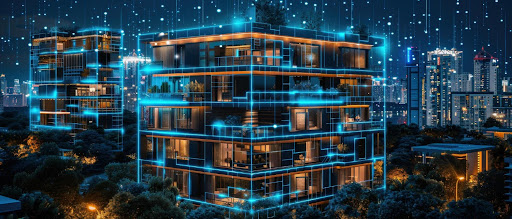Within the contemporary real estate environment, managers and owners of commercial properties continually look for mechanisms to improve efficiency in operations, lower costs, and increase the value of their assets. Of all the mechanisms that can drive these objectives in 2025, the best is the integration of a smart building management system. Smart systems are not simply technological upgrades; they are deliberate investments that pay tangible dividends through various aspects of building operations.
What is a Smart Building?
A smart building incorporates cutting-edge technologies—like IoT sensors, automation, data analytics, and real-time monitoring—into the facility infrastructure. These technologies are integrated to optimize lighting, HVAC, energy consumption, access control, security surveillance, and even water and waste management. All of these are converged via a smart building management system, allowing facility managers to manage and monitor building performance from one platform.
Understanding the ROI of Smart Building Systems
Even though the rollout of a smart building solution would entail an initial cost, the extended returns far and away exceed the expense. From better occupant comfort and energy conservation to increased valuation of the property, these systems directly influence operations and financial outcomes.
Energy Efficiency and Cost Savings
One of the most direct and concrete advantages of smart building technology is less energy usage. Intelligent climate control, motion detectors, and data-guided energy management can enable buildings to eliminate waste and run at maximum efficiency. HVAC and lighting are generally the biggest consumers of energy in a building, and they can be made to change automatically based on occupancy levels, time of day, or outside weather conditions.
These savings are not abstract. In most commercial buildings, implementing a smart building management system has resulted in energy savings of as much as 30%, which amounts to considerable cost savings in the long run.
Predictive Maintenance and Lower Downtime
Smart building systems have sensors and analytics software that give immediate feedback about equipment performance. Rather than adhering to reactive maintenance calendars, building operators are able to utilize predictive knowledge to repair problems prior to their occurrence. This minimizes downtime, maximizes asset lifespan, and eliminates the expense of emergency repairs or replacements.
Improved Occupant Experience
Modern tenants demand more from the buildings they inhabit—comfort, convenience, and connectivity are no longer negotiable. Smart buildings make it possible to have features like smart lighting, intelligent elevators, and adaptive HVAC that change based on personal preference or room usage. These advancements not only drive occupant satisfaction but also reduce retention levels, which is vital to sustaining stable rental revenue.
An enhanced tenant experience also improves reputation, making the property attractive to high-quality residents and gaining competitive edge in a saturated market.
Increased Operational Visibility and Control
With all building systems brought together within a centralized dashboard, facility managers have end-to-end visibility into performance metrics. This includes real-time insights on energy usage, equipment condition, security intrusions, and environmental conditions. With the smart building management system, rapid decision-making and instant reaction to anomalies can occur, making operations more agile and informed.
In portfolios of multiple properties, centralized control is even more beneficial, with standardized performance across locations and fewer on-site staff required.
Higher Property Value and Marketability
As technology and sustainability become pivotal to building standards, properties fitted with smart systems are more attractive to investors as well as tenants. Energy certification, smart infrastructure, and compliance with green laws all lead to increased appraisals. Purchasers and stakeholders perceive such buildings as future-proof, lower-risk assets with built-in cost-efficiency mechanisms.
The outcome is a direct addition to commercial property value, as a result of reduced operating expense, enhanced functionality, and higher tenant satisfaction.
Scalability and Future-Readiness
A critical advantage of smart building solutions is their scalability. As property requirements evolve or expand, new systems can be added and integrated without overhauling the existing infrastructure. From security and surveillance upgrades to integrating electric vehicle (EV) charging stations or smart parking systems, these solutions adapt to changing market needs.
In addition, as urban space transitions to sustainable and integrated living, smart building infrastructure makes sure that buildings are kept in sync with impending government regulations and industry expectations.
Data-Driven Decision Making
One of the lesser-heralded advantages of a smart building is access to actionable information. In-depth reporting of energy consumption, space usage, occupancy patterns, and environmental performance gives property managers the ability to optimize resources, modify leasing tactics, and minimize waste. In an aggressive real estate marketplace, data-driven decisions are an absolute advantage.
Conclusion
As the real estate sector further digitizes, smart building investments are becoming vital to optimizing return on investment. A properly installed smart building management system not only makes a building more efficient—it makes it more attractive, resilient, and profitable in the long term. By facilitating predictive maintenance, optimizing energy efficiency, and providing enhanced control over building operations, such systems contribute to enhancing commercial property value in a quantifiable manner.
Acceron delivers advanced, integrated building management solutions that adapt to the evolving needs of commercial properties. Their intelligent systems and adaptable framework enable the seamless integration of forward-looking technologies, optimized operational efficiency, and a competitive advantage in the real estate market.



